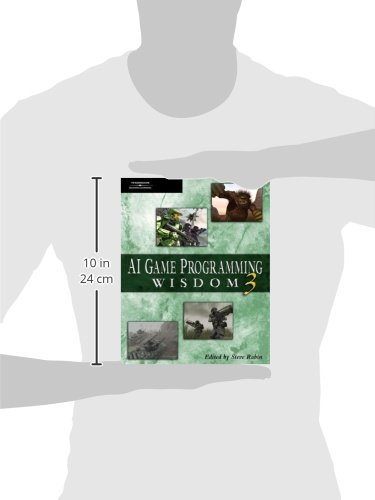


Full description not available
J**E
Five Stars
Great item
B**R
This is what the book is
i'm surprised more people haven't reviewed this book (there's only 1 review at the time i write this). It's a really, really good book, i expected more reviews.Since what this book is isn't exactly obvious from the description, i figured i should explain it.Like the first two volumes, this book is a collection of articles, generally 5-10 pages each. The book is roughly 800 pages long, so that's a lot of articles.Each article is on a different topic and most are written by different people. A handful of authors wrote two articles, but realize that a *lot* of people contributed to this, and each is an expert in different areas, have different writing styles and represent different games.i believe most of the authors are professional game AI developers who've worked on big name games. There are also articles by professors and game AI hobbyists (who shortly after writing in this series became professionals). Most write in a way you can understand, a few state things very simply, a few others use math and Greek letters and other things that give me headaches. The vast majority of articles are practical articles, not theory, and there's a fair number of examples (with code) given on the included CD.Because the articles are small, they tend to be focused on a single topic such as navmesh generation, path smoothing or player prediction through n-gram analysis. Since there are so many, the topics cover all sorts of things, from camera movement systems to baseball games to squad FPS tactics to steering race cars to generating random numbers with a normal/Guassian distribution. My favorites are the ones where a developer discusses some bright idea he had for a game and how it backfired on him.Given the sheer number of articles, it is almost guaranteed that you will find several articles that you don't like, several you don't understand, several you don't care abot and several you can't believe you lived without. If you're like me, you'll find one or two articles that are worth the purchase price of the book all by themselves.I suppose i should mention that i wrote a couple of articles in this series (though not this volume), so i'm obviously biased, but this really is a very good series. i probably should give it a 5 but i don't like giving 5s and, besides, not every one of the ~100 articles was excellent, just a lot of them.Now here's the important part: i teach a video game AI class and i don't use this book. Why? Because this is not a text book on how to write AI. It does not cover every topic a beginner needs to know to write a game. It does not build up a single example, walking you step by step through making a game. It most certainly dosn't teach you how to program. In many respects, this is a book written by professionals for professionals. It's a "tips and tricks" book. The assumption is that you know how to program or design a game. You don't have to be a genius to use this book, but it's not a cookbook or Dummies book either.There are a lot of other books on AI, most of them all-in-one, how to write AI books. Personally, there's only one or two i'd recommend, and none i couldn't live without. But i really don't think i can stress enough just how valuable this particular series is.
J**K
The State of the Art as it Exists Today
Computer gaming continues to grow at a very rapid rate. In fact much of the development of the new higher speed chips and of course the high performance video cards are being driven by the needs of the gaming people.Computer gaming software also continues to grow, perhaps even faster than gaming itself. Because of the rapid state of software development, no one author could possibly keep up with all of the changes that are taking place.So in this book Steve Rabin, of Nintendo of America has gotten almost sixty of the most advanced gaming software developers to write articles explaining the state of the art as they are helping to develop it. The writers come from a mix of software companies, universities, independent consultants, and game hardware developers. This is the state of the art in the development of artificial intelligence for games.
R**A
3rd time is a charm
I liked this book but liked the first one better. I long book with many articles.
L**C
Laying snares for patent trolls
The editors of this book chose to deliberately include an article on patented material written by the trolls who own the patent. The readers of this series are not looking for information that they cannot use. The worst part is that it is not clearly called out what ideas are patented, so someone skimming the article could miss the one line mention of the patent pending in the conclusion and wind up in a legal fiasco. I will not buy a later book in this series.
Trustpilot
1 month ago
4 days ago